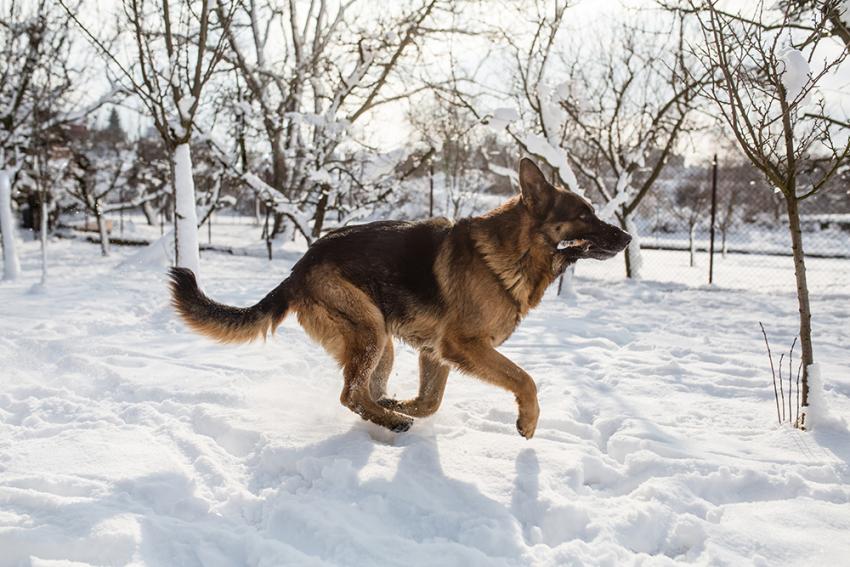Are you wondering how cold it is too cold for a German shepherd?
Then you should read this article for some helpful information. I’ll explain how you can protect your dog from unexpected cold weather conditions, based on my own experience with owning a German Shepherd.
What is the German Shepherd Cold tolerance?
Contents
German shepherds are a huge breed, and their coat is thick, so, unlike some other breeds, they do not become cold.
The thick layers of fur cover the dog’s body, insulating it from frostbite and letting him keep warm.
The thick layer of fur can even insulate the dog from the cold ground, which will keep him from feeling cold.
These dogs are active all year, but when temperatures drop, they start to slow down because they don’t feel as energetic.
Even a Shepherd dog, with its thick, heavy coat, can withstand cold temperatures.
Cold tolerance can be affected by the coat type, too. German shepherds with shorter and tighter coats have minimal cold tolerance.
Though every dog is different, behavioral adaptability, muscle mass, surface area to volume ratio, and coat type all play a role in German shepherd cold tolerance.
How cold is too cold for a German shepherd?
Although it varies on the breed of dog, there are normally three general stages of cold weather for dogs: The first stage is when the air temperature is between 32 and 45 degrees, and the wind is blowing from either rear or side.
Dogs allowed outside during this stage will experience cold, but they will be fairly comfortable.
You can wait as long as 24 hours for the dog to warm up, but if the weather gets significantly colder, you should try to bring your dog inside when the wind starts blowing from the side or rear.
Forty-five degrees Fahrenheit Even without the aid and application of dog jackets, and your dog may be able to withstand colder temperatures than you’re used to.
Have you ever seen a husky out on the trail? They’re incredibly resilient when it comes to cold weather.
This is because they have a thick, voluminous coat that naturally keeps them warm.
The temperature at which typical water starts to freeze is 32 degrees Fahrenheit.
That threshold is a bit higher for dogs, and dogs might start to feel uncomfortable at around 38 degrees Fahrenheit.
For some breeds, it’s even lower; some dog breeds start to feel chilly at just 32 degrees Fahrenheit.
Again, it varies on the individual dog, but older, younger, and younger dogs may be at higher risk.
If your pet is an older dog or has preexisting health issues, he may start to show signs of discomfort much earlier than normal.
Twenty degrees Fahrenheit Things start to seem exceedingly chilly around 15 degrees Fahrenheit.
At temperatures below 15 degrees Fahrenheit, dogs tend to retreat to wherever they have some protection from the wind.
They can feel quite chilled if they don’t have any shelter from the cold.
What can reduce German Shepherd Cold Tolerance?
Each German shepherd dog is different, and how they respond to cold weather will depend upon their fitness and age. Some dogs even have fur coats that keep them warm even when the weather is cold.
Height
Obviously, the most important factor in cold weather tolerance is the dog’s height – the longer the dog, the longer their heat retention time.
Age Young dogs generally have more body fat, so they lose heat faster and have problems staying warm.
Size
Puppies have a harder time creating and retaining heat in their bodies because they are still growing.
Age
Older dogs may have difficulty controlling their body temperature, so take care to warm them and remove any obstacles to their panting.
It’s important to help them maintain a regular routine of exercise to build up their energy and stamina. Also, take care to keep an eye on your dog to make sure they don’t go outside during a cold spell and become too cold.
Finally, make sure to have your vet perform an annual exam to ensure your dog’s health. Don’t forget to look in their eyes regularly to make sure they are alive and alert.
You should also keep a close eye on their breathing to make sure it is normal and not laboured. If you notice him panting or in distress, call your vet as soon as possible.
It may be time to take them in for a check-up. Every dog is different.
Some dogs are more tolerant of cold temperatures than others, depending on their breeds, outdoor play time, age, and health. Some dogs enjoy cold weather.
Many are indoor-only dogs who prefer to curl up in their beds to get warm.
Disease
When a German Shepherd is unwell, it’s important not to push its limits.
Too much exercise or intense heat can reduce its body temperature, making it more prone to colds. Therefore, it’s vital that its sick bed is warm.
A dog should always be kept in a warm place when it’s sick.
This leaves the dog with little energy for physical activity.
This illness can also cause the puppy or dog to become inactive. When this happens, cold or heatstroke can happen.
Heatstroke occurs when the body is unable to regulate its temperature, causing it to overheat. It is dangerous and can lead to death.
Many dogs that die every year are victims of heatstroke because they do not get enough exercise.
In the winter, life may feel like it’s getting colder and colder.
This means that your dog will turn its focus on its cold tolerance, such as by staying warmer than usual. Some dogs need to be kept warmer, either indoors or with a heated kennel or bed, in order to survive.
Color
Light hues absorb light, and therefore reflect more heat, whereas dark hues reflect light better.
As a result, dogs with black or brown coats tend to feel cold more quickly than dogs with white or grey coats.
This is because their black or brown skin has the ability to reflect more heat than other colors.
Therefore, assigning a dark color to your dog may increase its cold tolerance because it will feel less cold.
Body weight
Body fat increases cold tolerance because fat is Heat insulation.
Fat is a much better insulator than muscle or bone. Fat insulates the body by storing your body’s heat.
Fat insulates the body by storing your body’s heat. When dogs’ bodies need to absorb heat, fat is more efficient at storing heat.
While you may not want to add pounds to your dog’s body, studies have shown that body weight loss could help dogs endure the cold weather of a military expedition. Dogs are warm-blooded animals, and their bodies require a lot of energy to maintain their body temperature.
Therefore, some dogs will find it harder to tolerate the cold weather than others. If the dog maintains an exercise routine, it will help keep his body temperature regulated.
Also, since dogs have difficulty maintaining their body temperature when they are cold, they will naturally seek warmer places to sleep.
Coat length
When the temperatures drop, the coat should come off.
This helps keep your dog’s body temperature up. No dog has an efficient waterproof coat, so protect their paw pads by keeping them dry.
A short-haired GSD’s coat offers little insulation. Most breeds can benefit from being brushed every day.
Daily brushing stimulates your dog’s skin and fur, removes dirt, and keeps their coat healthy.
Brushing also helps expose matted fur, which you may be tempted to trim—but it’s better to consult your vet or a groomer first!
Then there are the long-haired “cold-weather” German shepherds, such as the Newfoundland.
These dogs do best in a frozen tundra-like climate, where winters are mild, and snow doesn’t build up.
Norwegian huskies and Siberian huskies are also suited to cold weather, but only in extreme climates.
Also Read: Do German Shepherds Get Cold?
Conclusion
German Shepherds have two ways of keeping themselves warm in cold conditions, both of which require a regular exercise regime.
The outer layer of their skin, called the hair or coat, absorbs heat. This reduces the amount of heat that your dog needs to stay warm.
The coat of a German Shepherd grows thicker in winter and the slower they grow. This means their coat is a little more difficult to keep warm, so they need health benefits to make up for it.
They have a thick coat of fur on their body to keep them warm and will then use their coat to cover their eyes and ears to protect them from the cold. Take into account your pet’s personality before deciding on an insulating coat.
Some pets are better at staying indoors, and some need the stimulation of being outdoors. A dog that is aggressive or over-excited will likely need more supervision and will need its fur to be thinner.
If it’s not too cold, take your buddy for a walk in the fresh air. Dogs are cold-blooded creatures, just like us, and they will go into hibernation if they’re cold and exposed to the cold for too long.
If they’re outside too long, and it starts to rain, they won’t be able to flee their warm house.




